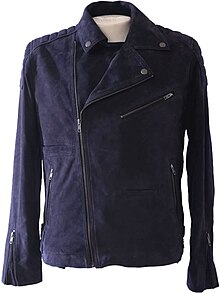

Suede (pronounced /sweɪd/ SWAYD) is a type of leather with a fuzzy, napped finish, commonly used for jackets, shoes, fabrics, purses, furniture, and other items.
Suede is made from the underside of the animal skin, which is softer and more pliable than the outer skin layer, though not as durable.
Etymology
The term comes from the French gants de Suède, which literally means "gloves from Sweden". The term was first used by The Oxford English Dictionary in 1884.
Production

Suede leather is made from the underside of the skin, primarily from lamb, although goat, calf, and deer are commonly used. Splits from thick hides of cow and deer are also sueded, but, due to the fiber content, have a shaggy nap.
Characteristics
| This section does not cite any sources. Please help improve this section by adding citations to reliable sources. Unsourced material may be challenged and removed. (August 2021) (Learn how and when to remove this message) |
Because suede does not include the tough exterior skin layer, it is less durable, but softer, than the standard "full-grain" leather. Its softness, thinness, and pliability make it suitable for clothing and delicate uses; suede was originally used for women's gloves, hence its etymology (see above). Suede leather is also popular in upholstery, shoes, bags, and other accessories, and as a lining for other leather products. Due to its textured nature and open pores, suede may become dirty and quickly absorb liquids. Suede is often used in place of leather when more breathability (air permeation) is needed such as with hot weather footgear.
Preservation and conditioning
A variety of environmental factors including salt, dirt, water, oils and moisture can stain or wear out suede. Since excess moisture can damage suede, it should not be cleaned with soap and water or machine washed. Suede brushes and suede rubbers, as well as a nail files, are tools that may be used to clean suede, often in conjunction with white vinegar or cornstarch. Suede protector spray can be applied after cleaning to preserve the integrity of the fabric longer.
In popular culture
- Suede's absorbent nature was highlighted in the Seinfeld episode "The Jacket", in which Jerry ventures outside into the snow and ruins his exorbitantly priced suede jacket.
- "Blue Suede Shoes" is a well-known early rock-n-roll song written by Carl Perkins and also covered by Elvis Presley.
- "Weird Al" Yankovic wrote and performed the song "King of Suede".
- "Suedehead" A skinhead subculture and song by English singer/songwriter Morrissey.
- "Johnny Suede" A film starring Brad Pitt where he plays a down and out musician with a huge pompadour haircut.
See also
- Nap (fabric)
- Shearing (textiles)
- Nubuck
- Voris, 1930s–1940s American fashion designer who worked exclusively in suede
References
- "Difference Between Leather and Suede - Explainry". Explainry. Archived from the original on 2017-08-23. Retrieved 2017-02-11.
- Suede, Dictionary.com
- Scrivano, Sandy (2001). Sewing with Leather and Suede: Tips, Techniques and Inspiration. Lark Books. p. 120. ISBN 978-1-57990-273-5.
- "Material Report: Suede". The Nowhere Nation. Retrieved 2024-08-26.
- Bennett, Jessica (2021-11-24). "How to Clean Suede Shoes Without Wrecking Their Velvety Texture". Better Homes & Gardens. Retrieved 2024-05-23.
- "How to Clean Suede Shoes and Boots". HGTV. 2021-01-13. Retrieved 2024-05-23.
Further reading
- American Leather Chemists Association ALC (1906). The Journal of the American Leather Chemists Association. American Leather.
- Bredenberg, Jeff (1999). Clean It Fast, Clean It Right: The Ultimate Guide to Making Absolutely Everything You Own Sparkle & Shine (New ed.). Rodale Books. p. 544. ISBN 1-57954-019-8.
- Burch, Monte (2002). The Ultimate Guide to Skinning and Tanning: A Complete Guide to Working with Pelts, Fur, and Leather (First ed.). The Lyons Press. p. 240. ISBN 1-58574-670-3.
- Churchill, James E. (1983). The Complete Book of Tanning Skins and Furs. Stackpole Books. p. 197. ISBN 0-8117-1719-4.
- Goldstein-Lynch, Ellen; Sarah Mullins; Nicole Malone (2004). Making Leather Handbags and Other Stylish Accessories. Quarry Books. p. 128. ISBN 1-59253-076-1.
- Kite, Marion; Roy Thomson (2005). Conservation of Leather and Related Materials. Butterworth-Heinemann. p. 240. ISBN 0-7506-4881-3.
- Michigan Historical Reprint Series (2005). The Art of Tanning Leather. Scholarly Publishing Office, University of Michigan Library. p. 266. ISBN 1-4255-2365-X.
- O'Flaherty, Fred; Roddy Lollar (1956). The Chemistry and Technology of Leather. ACS Monograph 134 (1978 ed.). American Chemical Society, Krieger Publishing Co. ASIN B007EUI5M4.
- Parker, Sybil P (1992). McGraw-Hill Encyclopedia of Science & Technology: An International Reference Work. New York: McGraw-Hill. p. 508. ISBN 0-07-909206-3.
External links
 Media related to Suede at Wikimedia Commons
Media related to Suede at Wikimedia Commons
| Leather | |
|---|---|
| Types | |
| Leather sources | |
| Processes | |
| Crafting | |
| Substitutes | |
| Leather museums | |
| Related | |